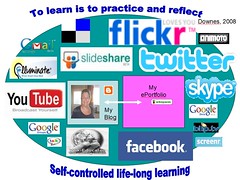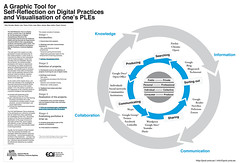opportunities to integrate Web 2.0 tools in higher education McLoughlin and Lee make an argument that higher education needs to change in the direction of more student centered and self regulated learning as a consequence of an abundance of information and web tools available. They posit that educators be prepared to accept learners' needs and preferences and not just design static courses where tasks are preselected and resources are prescribed rather than negotiated.
However, universities are conservative and in those cases where information technologies are used they tend to rely on conservative established virtual learning environments (VLEs) or learning management systems (LMSs) which do not permit connectivity to social networks on the net. Actually, most of the learning management systems replicate traditional modes of learning and build on a classroom metaphor.
A promising approach that will possibly break with old traditions is to promote personal learning environments (PLEs). In a traditional LMS (of VLE) content is composed, organised and packaged in advance; in a PLE tasks are repurposed (mashed up) with the students own applications and contributions, which are later further syndicated for others to use.
Notably, the authors identify two different interpretations of PLEs. In one case educators understand the need for personalisation and learner centeredness but they still provide the tasks and resources. McLoughlin and Lee label it a provider driven approach. The other interpretation adopts a view of a wholly learner driven approach which consequently transcends the walls of the classroom.
In the second case learners exercise ownership and control rather than being constrained by instructor controlled and pre-packaged materials. Both PLE models, however, challenge higher education to harness the many resources that exist outside of the formal spaces of the institution. Another challenge concerns expertise. When external resources are made use of, the teacher might not be the sole expert who is dispensing knowledge and prescribing resources. And that leads us to a closer look at the student role
As web 2.0 is highly incongruent with a control culture we need to rethink our strategies and view students as active participants and co-producers rather than passive consumers to be filled up with content which then is supposed to be recalled in subsequent examinations. Learning processes are participative, something that Lave and Wenger showed a long time ago. In joining a community of learning they develop their own mastery but also have a responsibility to play a part in the continued advancement of the community's existing body of knowldege.
However, student generated content has generally been marginalised in the ecucational system. Admittedly, students do produce lots of academic artefacts such as essays and reports but these are almost exclusively used for assessment purposes and are seldom read by many neither are they further used. If we expand our view and treat student products as sources of knowledge we also invite students to be producers as well as consumers of knowledge.
Unfortunately, many students are used to answering questions already answered and being assessed for their success to do that. Therefore a transition to self regulated learning the way it is depicted by PLEs is not without problems. McLoghlin and Lee asks the question: How can the ideal balance between scaffolded and learner directed approaches be achieved?
I guess that is what we have to find out in the near future.

This work is licensed under a Creative Commons Attribution-NonCommercial-ShareAlike 3.0 Unported License







Inga kommentarer:
Skicka en kommentar